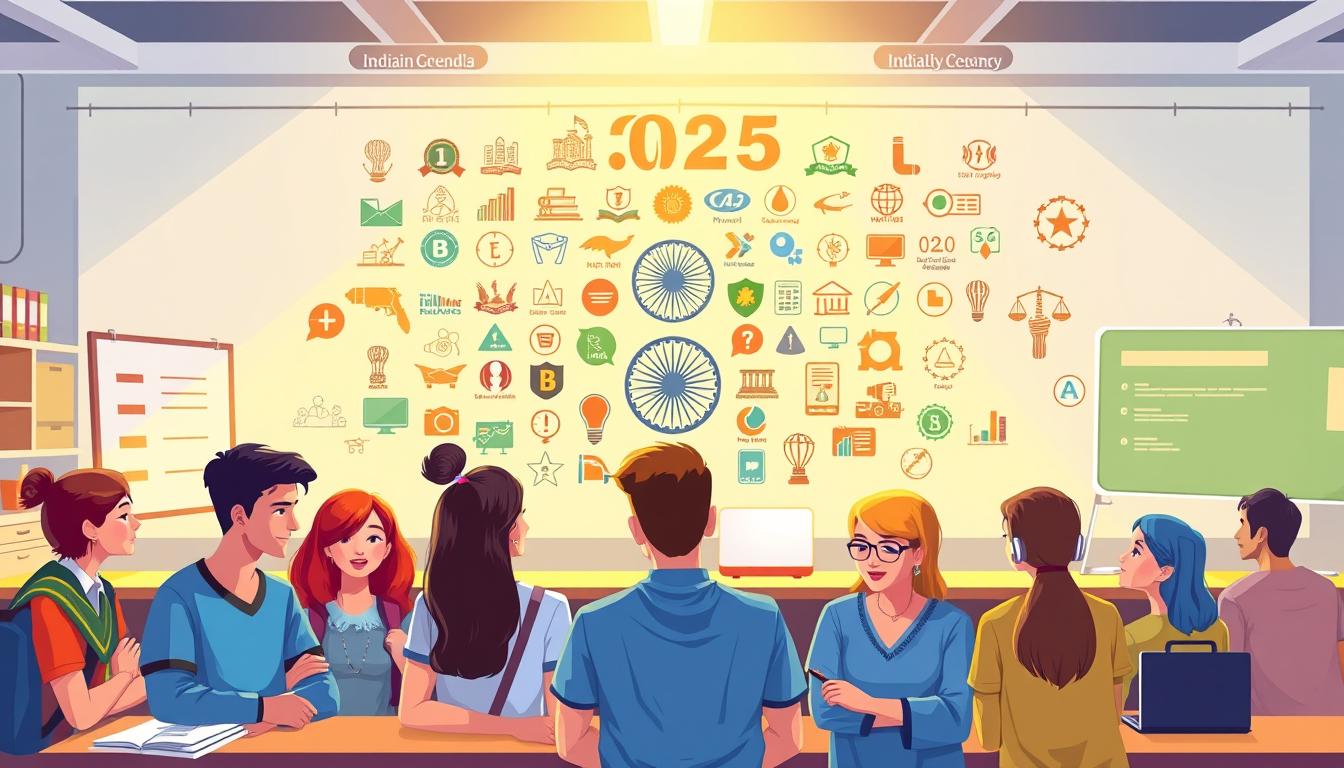The Indian government has launched numerous initiatives to support students across the country, aiming to enhance learning outcomes and promote academic success. These schemes address various challenges in the education system, providing financial support, infrastructure development, and skill enhancement opportunities.
The initiatives promote equal access to quality education across different socioeconomic backgrounds and geographical regions, aligning with India’s National Education Policy. The schemes cover various categories, from school education to research scholarships, playing a crucial role in students’ academic success and career development.
- The Current State of Education in India
- Why Government Educational Schemes Matter
- School Education Schemes
- Schemes for Girl Child Education
- Digital Education Initiatives
- Undergraduate Scholarship Programs
- Postgraduate and Research Scholarships
- Schemes for Professional and Technical Education
- Schemes for Minority Students
- Schemes for SC/ST/OBC Students
- Schemes for Students with Disabilities
- Skill Development and Vocational Training Programs
- Study Abroad Scholarships and Programs
- How to Apply for Government Educational Schemes
- Future of Educational Schemes in India
- Conclusion
- FAQ
- What are the eligibility criteria for government educational schemes in India?
- How can students apply for government scholarships?
- What is the purpose of the Beti Bachao Beti Padhao scheme?
- What is the difference between PM SHRI and Samagra Shiksha Abhiyan?
- Are there any schemes specifically for students with disabilities?
- How do digital education initiatives like PM e-VIDYA and DIKSHA work?
- Can students from minority communities avail of government scholarships?
- What is the role of the National Scholarship Portal in applying for government scholarships?
- Are there any schemes that support skill development and vocational training?
- How can students stay updated about new government educational schemes?
Key Takeaways
- Government schemes support students across India, enhancing learning outcomes.
- Initiatives address challenges in the education system.
- Promoting equal access to quality education.
- Aligning with India’s National Education Policy.
- Covering various categories, from school education to research scholarships.
The Current State of Education in India
Understanding the current education landscape in India is crucial for identifying the challenges and opportunities that lie within its vast and diverse educational system. The country’s education sector is a critical component of its development, influencing not only individual outcomes but also the nation’s overall progress.
Education Statistics and Literacy Rates
India’s education statistics reveal a complex picture of progress and challenges. As of the latest data, the literacy rate in India stands at approximately 77.7%, with significant variations between urban and rural areas. Urban regions tend to have higher literacy rates compared to their rural counterparts, highlighting a persistent disparity.
| Region | Literacy Rate (%) |
|---|---|
| Urban | 85.2 |
| Rural | 73.0 |
| Overall | 77.7 |
The gender disparity in literacy rates is another area of concern, with female literacy rates generally lower than those of males, particularly in rural areas. Efforts to bridge this gap have shown progress over the last decade, with initiatives aimed at improving girls’ education and overall educational outcomes.
Challenges in the Indian Education System
Despite progress, the Indian education system faces numerous challenges, including infrastructure deficiencies, teacher shortages, and varying quality of learning. High dropout rates, particularly in secondary education, remain a significant issue. Socioeconomic factors play a substantial role in educational access and quality, creating disparities between different regions and population segments.
The COVID-19 pandemic has exacerbated existing educational challenges, causing learning losses and highlighting the digital divide in Indian education. The pandemic has underscored the need for equitable learning opportunities in an increasingly technology-dependent educational environment. In response, the government has introduced various educational schemes and policy initiatives aimed at transformative development in the education sector.
Key Challenges:
- Infrastructure deficiencies
- Teacher shortages
- Quality of learning
- High dropout rates
- Digital divide
Addressing these challenges is crucial for improving educational outcomes and ensuring that all students have access to quality education.
Why Government Educational Schemes Matter
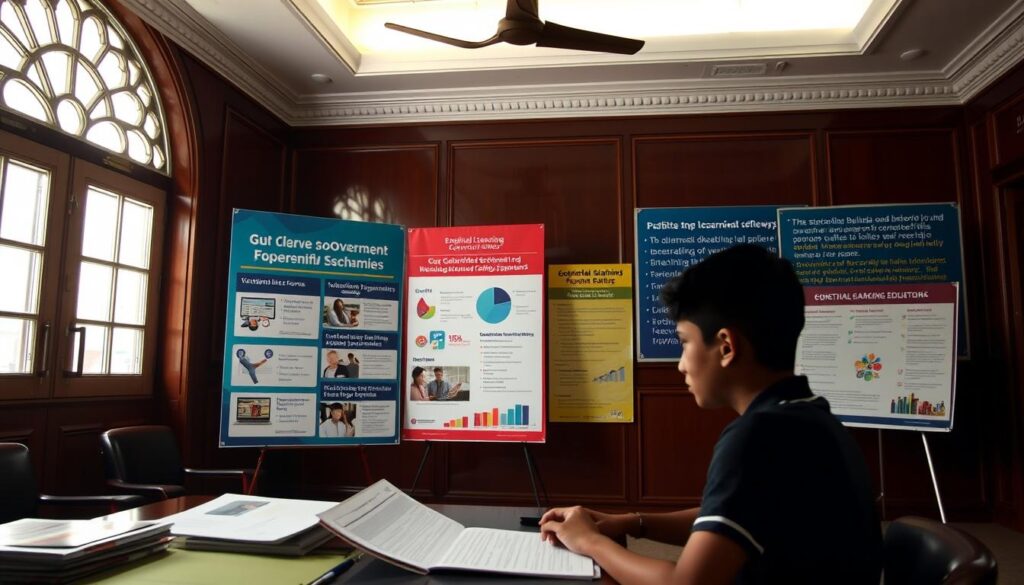
Educational schemes launched by the government play a vital role in shaping the country’s educational landscape. These initiatives are designed to improve the quality of education and make it more accessible to students from diverse backgrounds. By providing financial support, infrastructure development, and policy reforms, government educational schemes aim to bridge the gap between different socioeconomic groups and regions.
Bridging the Educational Gap
Government educational schemes are instrumental in democratizing access to quality education across India. They help bridge the educational gap between privileged and underprivileged communities, urban and rural areas, and different genders. By providing targeted support, these schemes ensure that all students have an equal opportunity to succeed. For instance, initiatives like scholarships and mid-day meal programs encourage enrollment and retention, particularly among disadvantaged groups.
The educational gap is a significant challenge in India, with disparities in access to quality education affecting various segments of the population. Government schemes address this issue by providing resources and infrastructure to under-resourced areas, thereby promoting educational equality.
Economic Benefits of Educational Support
Investing in education through government schemes has numerous economic benefits. It leads to increased workforce productivity, higher earning potential, and overall economic development for the nation. By enhancing human capital, these schemes contribute to a more skilled and educated population, which is crucial for India’s global competitiveness.
Moreover, government investment in education creates a positive return on investment through improved human capital development and reduced social welfare costs. By breaking intergenerational cycles of poverty and promoting social mobility, educational schemes play a critical role in achieving broader national development goals.
In conclusion, government educational schemes are essential for fostering a culture of learning and promoting economic growth. By addressing the educational needs of diverse populations, these initiatives contribute to a more equitable and prosperous society.
School Education Schemes
To enhance the quality of education, the Indian government has introduced various school education schemes aimed at improving learning outcomes and infrastructure across the country.
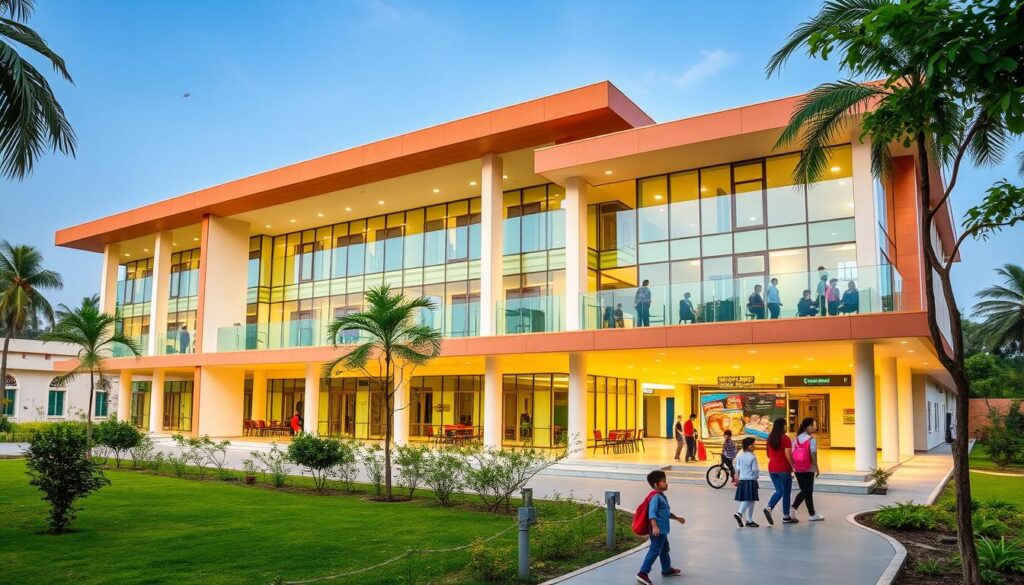
PM SHRI (PM Schools for Rising India)
The PM SHRI initiative aims to develop exemplary schools that provide quality education and serve as models for other schools. These schools will focus on holistic development, incorporating modern infrastructure, and innovative teaching methods.
The objective is to create an enabling environment that fosters academic excellence and overall growth among students. By serving as benchmarks, PM SHRI schools will drive improvements in the education system nationwide.
Samagra Shiksha Abhiyan
Samagra Shiksha Abhiyan represents a holistic approach to education, integrating various schemes to provide comprehensive support from pre-school to senior secondary levels. The program focuses on improving access, equity, and quality in education.
By consolidating previously separate schemes, Samagra Shiksha Abhiyan ensures a seamless educational experience, addressing gaps in infrastructure, teacher training, and student support.
Mid-Day Meal Scheme
The Mid-Day Meal Scheme is a significant initiative aimed at improving nutrition among school children while enhancing enrollment, attendance, and retention rates. By providing free meals, the scheme addresses hunger and supports the overall well-being of students.
Implemented across various states, the scheme has shown positive impacts on educational outcomes and child health.
National Means-cum-Merit Scholarship
The National Means-cum-Merit Scholarship supports talented students from economically disadvantaged backgrounds, enabling them to continue their education at the secondary level. The scholarship is awarded based on merit and financial need.
By providing financial assistance, the scheme helps reduce dropout rates and encourages students to pursue higher education.
These school education schemes collectively address various aspects of educational challenges, from infrastructure development to student retention and learning outcomes. Recent modifications and enhancements made to these schemes for 2025 include increased funding allocations, expanded coverage, and improved implementation mechanisms.
Success stories and statistical improvements in educational indicators resulting from these initiatives are evident across different states in India, highlighting the positive impact of these government schemes on the education sector.
Schemes for Girl Child Education
Girl child education is being significantly boosted by various government schemes. These initiatives aim to address the specific challenges faced by girls in accessing and completing their education.
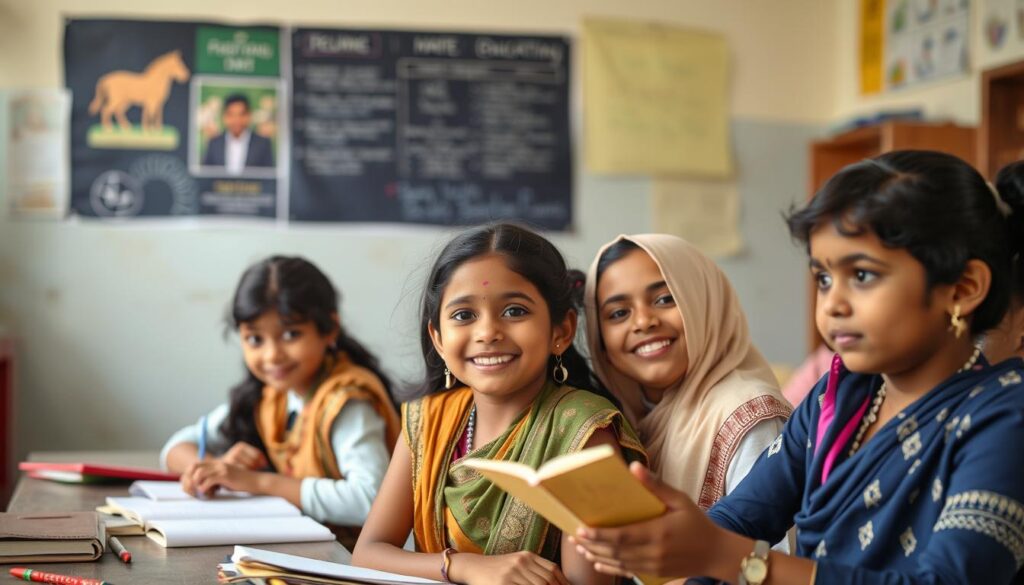
Beti Bachao Beti Padhao
The Beti Bachao Beti Padhao (BBBP) scheme is a flagship program launched by the Government of India to address the declining Child Sex Ratio and promote girls’ education. BBBP has a three-fold approach: preventing gender-biased sex-selective practices, ensuring survival and protection of the girl child, and promoting education and participation of girls.
This campaign has been instrumental in changing societal attitudes towards the girl child, encouraging families to educate their daughters.
UDAAN Scheme
The UDAAN Scheme is designed to increase the enrollment of girls in technical education, particularly in engineering and other professional programs. It provides free coaching to girl students to help them prepare for entrance exams.
UDAAN also offers mentorship support, guiding girls through their educational journey and helping them overcome the challenges they face in male-dominated fields.
National Scheme of Incentive to Girls for Secondary Education
The National Scheme of Incentive to Girls for Secondary Education provides financial incentives to girls from economically weaker sections to encourage them to continue their education beyond the secondary level.
This scheme has been effective in reducing dropout rates among adolescent girls by providing them with the financial support needed to pursue higher education.
These schemes collectively address the barriers to girls’ education, including social norms, early marriage, and safety concerns. By promoting gender equality in education, they contribute to the overall development of society.
The effectiveness of these schemes is evident in the improved enrollment rates and academic performance of girls. Regional success stories highlight the positive impact of these initiatives on changing societal attitudes towards female education.
Digital Education Initiatives
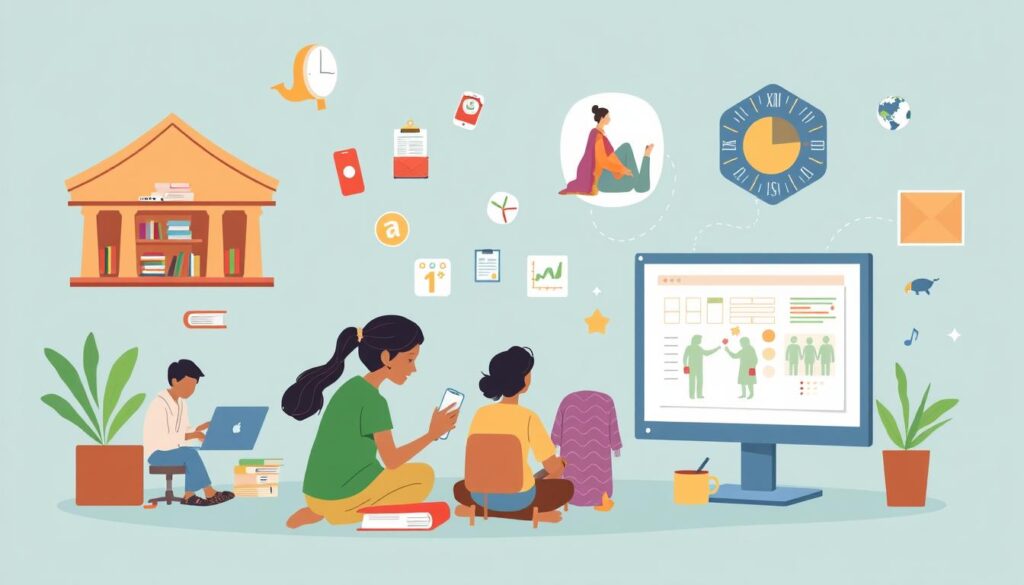
Digital education has become a cornerstone of India’s educational strategy, with initiatives like PM e-VIDYA leading the way. The government has recognized the potential of digital learning to bridge the educational gap and has launched several key initiatives to enhance the quality of education across the country.
PM e-VIDYA
The PM e-VIDYA initiative is a multi-channel approach to digital education, utilizing TV channels, radio, podcasts, and digital platforms to ensure continuity of learning. This initiative has been particularly crucial during times of disruption, such as the COVID-19 pandemic, by providing students with access to educational content through various mediums.
Key Features: Multi-channel access, digital platforms, TV channels, radio, and podcasts.
DIKSHA Platform
The DIKSHA platform serves as India’s national digital infrastructure for teachers, offering teaching resources, professional development opportunities, and assessment tools. It has become a vital resource for educators, enhancing their ability to provide quality education.
Benefits: Enhanced teaching resources, professional development, and assessment capabilities.
Swayam and Swayam Prabha
Swayam and Swayam Prabha are initiatives aimed at democratizing access to quality higher education across India. Swayam offers free online courses, while Swayam Prabha provides educational content through TV channels, ensuring that students from all backgrounds have access to educational resources.
Impact: Expanded access to quality education, particularly in remote and underserved areas.
These digital education initiatives are not only addressing the challenges of the digital divide through innovative approaches like offline access options and multi-device compatibility but are also transforming traditional teaching-learning processes. By integrating emerging technologies such as AI, virtual reality, and adaptive learning, these platforms are enhancing personalized learning experiences for students and preparing them for a technology-driven future.
Moreover, the impact of these digital platforms on expanding educational access, particularly during disruptions like the COVID-19 pandemic, has been significant. They have supported teachers in adopting new pedagogical approaches, thereby improving the overall quality of education.
Undergraduate Scholarship Programs

To address the diverse needs of undergraduate students, the Indian government has introduced multiple scholarship programs. These initiatives aim to promote higher education and support students from various backgrounds, including those from economically weaker sections, girls, and students from the North Eastern Region.
Central Sector Scholarship Scheme
The Central Sector Scholarship Scheme is a prestigious program designed for meritorious students. To be eligible, students must have a family income below a certain threshold and have secured a minimum of 80% marks in their previous academic year. The scholarship amount is substantial, helping to cover tuition fees and other educational expenses.
Ishan Uday Scholarship for North Eastern Region
The Ishan Uday Scholarship is specifically designed for students from the North Eastern Region, aiming to promote higher education in this historically underserved area. The scholarship covers tuition fees, living expenses, and other educational costs, ensuring that deserving students can pursue their undergraduate studies without financial constraints.
Pragati Scholarship for Girls in Technical Education
The Pragati Scholarship is a significant initiative to encourage girls to pursue technical education. By providing financial support, this scholarship aims to bridge the gender gap in STEM fields. Eligible students receive a substantial scholarship amount to support their undergraduate studies in technical disciplines.
Prime Minister’s Scholarship Scheme
The Prime Minister’s Scholarship Scheme is designed for the wards of defense personnel, offering them financial assistance to pursue higher education. This scheme recognizes the sacrifices made by defense families and provides them with the necessary support to achieve their academic goals.
These undergraduate scholarship programs collectively address various dimensions of educational access, including regional disparities, gender gaps, economic barriers, and special group needs. By providing financial support and other benefits, these schemes enable students to focus on their studies and achieve academic excellence.
The application processes for these scholarships involve submitting relevant documents, meeting specific eligibility criteria, and adhering to deadlines. Prospective applicants must carefully review the requirements for each scholarship to ensure they are eligible and can submit a complete application.
Success stories of scholarship recipients highlight the positive impact of these programs. Many students who have benefited from these scholarships have gone on to achieve great things in their careers, contributing to the nation’s knowledge and skills base.
Postgraduate and Research Scholarships
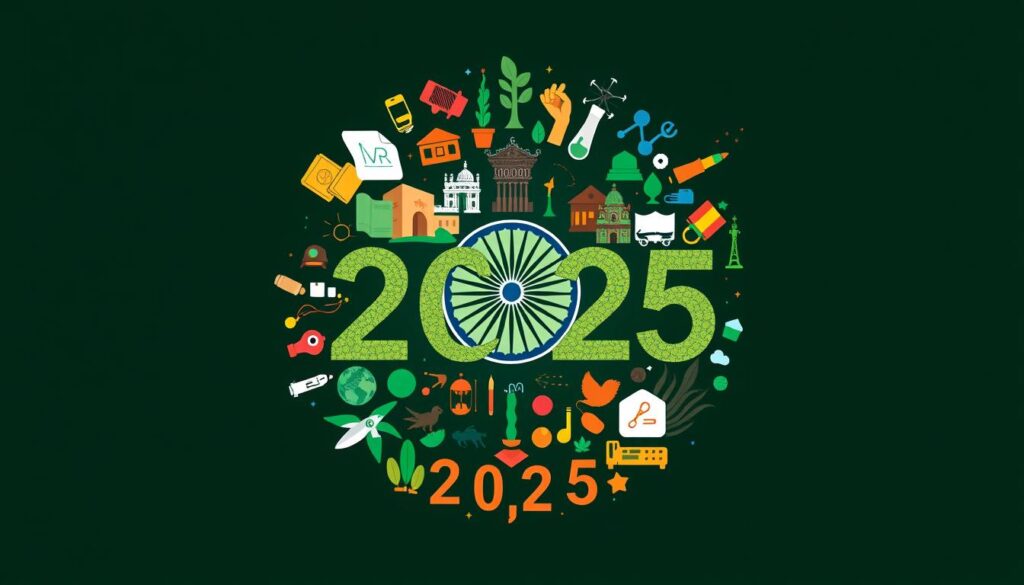
Postgraduate and research scholarships are pivotal in fostering a culture of innovation and research in India. These scholarships not only support students financially but also encourage them to pursue advanced studies and research in various fields.
Prime Minister Research Fellowship
The Prime Minister Research Fellowship (PMRF) is a prestigious award that aims to attract the best talent into research-based doctoral programs at premier institutions such as IITs and IISERs. The fellowship provides financial support to students pursuing research in science, technology, engineering, and mathematics (STEM) fields.
National Scholarship Portal Schemes
The National Scholarship Portal (NSP) is a digital platform that offers various postgraduate scholarship schemes. These schemes cater to students pursuing master’s and doctoral studies, providing them with financial assistance to achieve their academic goals.
INSPIRE Scholarship for Higher Education
The INSPIRE Scholarship for Higher Education is designed to nurture talented students in science and research. By providing financial support throughout their academic journey, this scholarship encourages students to pursue higher education and research careers.
These research-oriented scholarships align with India’s national priorities in science, technology, and innovation, addressing the need for developing indigenous research capabilities. By supporting high-quality research, these scholarships contribute to increasing India’s research output, patent filings, and contributions to global scientific knowledge.
Recipients of these prestigious scholarships have various career pathways and opportunities available to them, including academic positions, research roles in industry, and entrepreneurship possibilities. By comparing these scholarship programs with international research funding opportunities, it becomes evident that they play a crucial role in stemming brain drain by supporting high-quality research within India.
Schemes for Professional and Technical Education
India’s push for excellence in professional and technical education is backed by several government-funded schemes. These initiatives are designed to support students in accessing quality education and training in various technical and professional fields.

AICTE PRAGATI and SAKSHAM Schemes
The All India Council for Technical Education (AICTE) has introduced the PRAGATI and SAKSHAM schemes to support girls and differently-abled students pursuing technical education. The AICTE PRAGATI scheme provides scholarships to girls, promoting gender equality in technical education.
The AICTE SAKSHAM scheme focuses on supporting differently-abled students through scholarships and accessibility measures, ensuring inclusivity in technical education.
Education Loan Interest Subsidy Scheme
The Education Loan Interest Subsidy Scheme is designed to provide financial assistance to students pursuing professional and technical courses. It covers the interest during the moratorium period, making education more accessible to economically disadvantaged students.
Eligibility is based on family income, and the application process is streamlined to ensure ease of access.
These schemes collectively address financial barriers to accessing quality professional and technical education, particularly for underrepresented and economically disadvantaged groups. By analyzing the impact of these initiatives, it is evident that they have contributed significantly to increasing enrollment and diversity in professional courses such as engineering, management, and pharmacy.
The alignment of these schemes with industry needs has helped develop a skilled workforce for India’s growing technical and professional sectors. Recent enhancements to these schemes for 2025 include increased subsidy amounts, expanded course coverage, and streamlined application processes, further improving accessibility.
Schemes for Minority Students

The Indian government has launched several initiatives to support minority students in their educational pursuits. These schemes aim to promote inclusivity and provide equal opportunities for all religious communities.
Maulana Azad National Fellowship
The Maulana Azad National Fellowship is a prestigious program designed to support minority students pursuing research degrees such as M.Phil. and Ph.D. in Indian universities. This fellowship provides financial assistance to cover tuition fees, living expenses, and other research-related costs, enabling students to focus on their academic and research endeavors.
The fellowship is named after Maulana Abul Kalam Azad, a prominent figure in Indian history, and is administered by the Ministry of Minority Affairs. It is awarded to students who demonstrate academic excellence and a commitment to research in their chosen fields.
Pre and Post Matric Scholarships for Minorities
The government offers Pre-Matric and Post-Matric Scholarships to minority students to encourage them to continue their education. The Pre-Matric Scholarship is awarded to students studying in classes 1-10, while the Post-Matric Scholarship supports students in classes 11-12 and higher education.
These scholarships cover various educational expenses, including tuition fees, maintenance allowances, and other related costs. The eligibility criteria include belonging to a religious minority community and meeting specific family income thresholds.
The impact of these scholarships has been significant, with increased enrollment rates and reduced dropout rates among minority communities. The schemes have also contributed to improving educational outcomes and promoting social inclusion.
Recent modifications to these schemes for 2025 include increased scholarship amounts, simplified application procedures, and expanded institutional coverage. These changes aim to enhance the effectiveness and reach of the programs, ensuring that more minority students can benefit from them.
Schemes for SC/ST/OBC Students
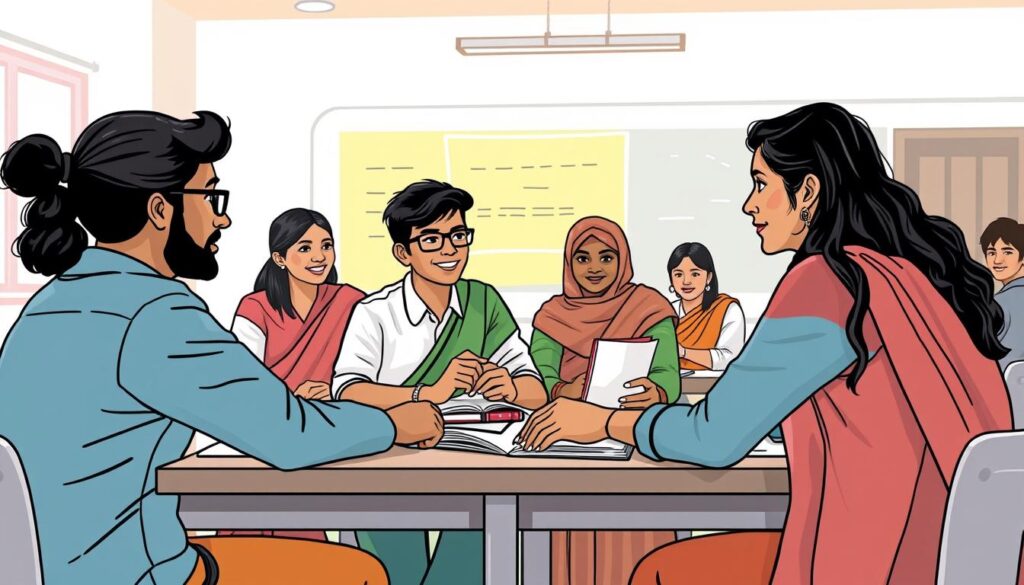
The Indian government has introduced several schemes to support SC/ST/OBC students in their pursuit of higher education. These initiatives aim to address historical educational disparities and promote social justice through affirmative action.
National Fellowship for SC Students
The National Fellowship for SC Students is designed to increase the representation of Scheduled Caste students in higher education research programs. This fellowship provides financial support for pursuing M.Phil. and Ph.D. degrees, enabling students to focus on their research without financial burdens.
Top Class Education Scheme for SC Students
The Top Class Education Scheme for SC Students supports SC students in pursuing education at premier institutions like IITs, NITs, IIMs, and other designated institutions of excellence. This scheme covers tuition fees, living expenses, and other related costs, ensuring that students can focus on their studies without financial constraints.
National Overseas Scholarship for SC Students
The National Overseas Scholarship for SC Students provides financial assistance to SC students pursuing Master’s, Ph.D., and Post-Doctoral studies abroad. The scholarship covers tuition fees, living expenses, and travel costs, enabling students to access global educational opportunities.
Collectively, these schemes address historical educational disparities and promote social justice through affirmative action in the education sector. By increasing representation of SC/ST/OBC students in prestigious educational institutions and advanced fields of study, these initiatives contribute to a more equitable society.
Recent enhancements to these schemes for 2025 include increased funding allocations, expanded institutional coverage, and improved support services to ensure student success. These changes reflect the government’s commitment to promoting educational equality and supporting marginalized communities.
Schemes for Students with Disabilities
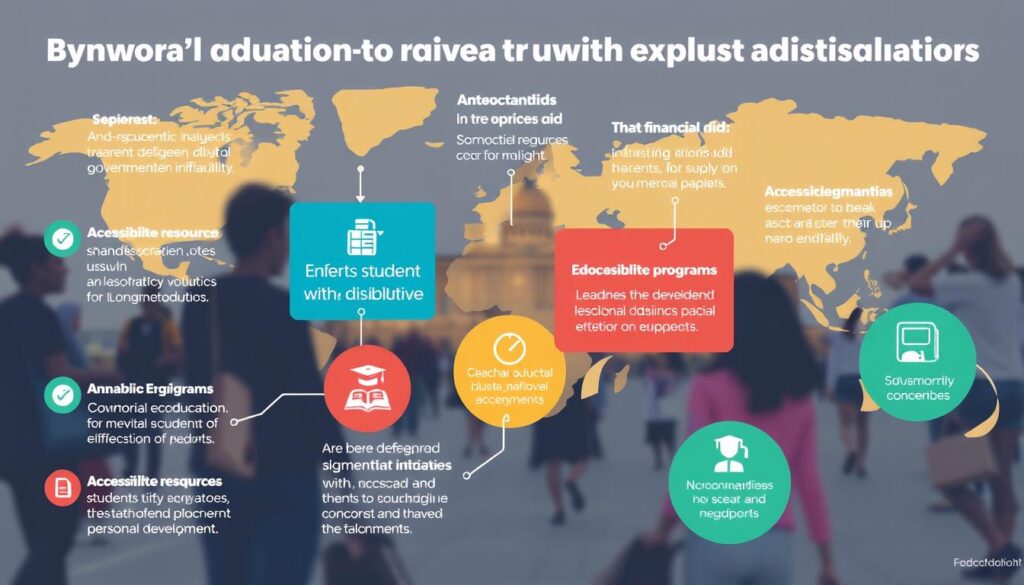
The government has introduced multiple programs to enhance educational access for students with disabilities, recognizing the importance of inclusive education in fostering a more equitable society.
These initiatives are designed to address the unique challenges faced by students with disabilities, including physical accessibility, learning accommodations, and financial barriers. By providing targeted support, the government aims to increase enrollment and retention rates among students with disabilities across different levels of education.
Pre-Matric and Post-Matric Scholarships
The Pre-Matric and Post-Matric Scholarships for students with disabilities are crucial in providing financial assistance to ensure that these students can continue their education without undue financial burden.
Pre-Matric Scholarships are awarded to students with disabilities who are pursuing education at the pre-matric level. The eligibility criteria include a disability certification, and the scholarship covers various educational expenses.
Post-Matric Scholarships support students with disabilities who are pursuing higher education after completing class 10. This scholarship helps cover expenses such as tuition fees, books, and other educational materials.
National Fellowship for Persons with Disabilities
The National Fellowship for Persons with Disabilities aims to increase the participation of differently-abled students in research programs. This fellowship provides financial support to students pursuing research in various fields, enabling them to contribute to academic and research communities.
The selection process for the fellowship is based on merit, and the financial provisions are designed to cover research expenses and living costs, ensuring that the recipients can focus on their research without financial constraints.
Recent enhancements to these schemes for 2025 include expanded disability coverage, increased scholarship amounts, and improved support services to ensure inclusive educational experiences.
These initiatives are part of a broader effort to create a more accessible and supportive education system, integrating barrier-free infrastructure, assistive technologies, and specialized learning resources.
Skill Development and Vocational Training Programs

With the aim of bridging the gap between education and employment, the Indian government has implemented several skill development initiatives. These programs are designed to provide industry-relevant training to the youth, making them more employable in the competitive job market.
Pradhan Mantri Kaushal Vikas Yojana (PMKVY)
The Pradhan Mantri Kaushal Vikas Yojana (PMKVY) is a flagship scheme launched by the government to provide skill training to the youth. The program aims to provide industry-relevant skill training to enable the youth to secure better livelihood. PMKVY is implemented through a robust infrastructure that includes training centers, assessment agencies, and certification bodies.
The certification process under PMKVY is aligned with the National Skills Qualification Framework (NSQF), ensuring that the trainees receive certification that is recognized across the country. This framework enables the trainees to get placement in various industries, thereby enhancing their employability.
National Apprenticeship Training Scheme
The National Apprenticeship Training Scheme is another significant initiative that combines practical training with theoretical instruction. This program is designed to prepare students for skilled employment across various industrial sectors. The scheme allows apprentices to gain hands-on experience in their chosen trade, making them more attractive to potential employers.
The National Apprenticeship Training Scheme is implemented in collaboration with industries, ensuring that the training is aligned with the current market demands. This industry-partnered approach helps in addressing the skills gap in various sectors of the Indian economy.
These skill development initiatives have shown a positive impact on enhancing employability and increasing job placements. By focusing on practical, job-oriented training, these programs have been able to bridge the gap between formal education and industry requirements.
The industry partnerships and employer engagement strategies have strengthened these vocational training programs, ensuring their relevance to current market demands. The recent enhancements to these programs for 2025 include new sector-specific training modules, advanced technology integration, and improved post-training support services for job placement.
Study Abroad Scholarships and Programs

Studying abroad can be a life-changing experience, and the Indian government provides several scholarships to support this endeavor. These programs are designed to promote global education, enhance research opportunities, and foster knowledge transfer between India and other countries.
National Overseas Scholarship
The National Overseas Scholarship is a prestigious program aimed at supporting students from marginalized communities in pursuing higher education at prestigious international universities. This scholarship covers tuition fees, living expenses, and other educational costs, enabling deserving students to access world-class education.
GIAN (Global Initiative of Academic Networks)
GIAN is an innovative program that brings international faculty to Indian institutions for short-term teaching and research collaborations. This initiative benefits students who cannot study abroad by providing them with exposure to global teaching methods and research expertise, thereby enhancing their learning experience.
Scholarship for Indian Students to Study Abroad
Various government scholarships are available for Indian students to study abroad, including country-specific programs, subject-specific grants, and exchange initiatives supported by bilateral agreements. These scholarships not only provide financial support but also offer opportunities for cultural exchange and global networking.
These international education opportunities contribute significantly to knowledge transfer, global exposure, and enhancing India’s human capital. By accessing world-class education and research facilities, Indian students can acquire specialized skills and knowledge that can be applied to drive innovation and development in their home country.
The selection criteria, application processes, and financial coverage of these international scholarship programs vary. However, they generally require a strong academic record, letters of recommendation, and a clear statement of purpose. Aspiring applicants must carefully review the eligibility criteria and application guidelines to ensure successful submissions.
Many scholarship recipients have successfully studied at prestigious global institutions and returned to contribute to India’s development in various fields. Their experiences and success stories serve as inspiration for future applicants and demonstrate the positive impact of these international education initiatives.
These international education initiatives align with India’s foreign policy objectives and knowledge diplomacy efforts while addressing domestic skill gaps in specialized fields. By fostering global collaborations and enhancing the skills of Indian students, these programs play a crucial role in promoting India’s global presence and competitiveness.
How to Apply for Government Educational Schemes
To avail of the numerous government educational schemes, students must navigate through a structured application process. Understanding the steps involved can significantly enhance their chances of securing financial assistance and other benefits.
National Scholarship Portal Guide
The National Scholarship Portal is a crucial platform for students to apply for various government educational schemes. To begin, students need to register on the portal by providing basic information such as name, date of birth, and contact details.
Once registered, students can log in and search for relevant scholarship schemes based on their eligibility criteria. The portal provides a user-friendly interface to fill out application forms, upload required documents, and track the status of their applications.
Essential Documents Required
When applying for government educational schemes, students need to gather and submit several essential documents. These typically include:
- Identity proof (Aadhaar card, passport, etc.)
- Income certificates
- Caste certificates (if applicable)
- Disability certificates (if applicable)
- Academic records (marksheets, certificates, etc.)
- Bank account information
Ensuring that these documents are accurate and up-to-date is crucial for a successful application.
| Document Type | Description | Importance |
|---|---|---|
| Identity Proof | Aadhaar card, passport, etc. | High |
| Income Certificate | Proof of family income | High |
| Caste Certificate | For reserved category students | Medium |
| Academic Records | Marksheets, certificates, etc. | High |
Common Application Mistakes to Avoid
Students often make mistakes that can lead to the rejection of their applications. Common errors include:
- Incomplete application forms
- Missing or incorrect documents
- Incorrect bank account details
- Missing deadlines
To avoid these pitfalls, students should carefully review their applications before submission and ensure that all information is accurate and complete.
By following these guidelines and understanding the application process, students can enhance their chances of securing benefits from government educational schemes.
Future of Educational Schemes in India

India’s educational landscape is on the cusp of a revolution, driven by the National Education Policy 2020. This policy has introduced significant changes to the education system, focusing on flexibility, multidisciplinary education, and skill development integrated with academic learning.
New Initiatives Under National Education Policy
The National Education Policy 2020 is reshaping government educational schemes with its emphasis on multidisciplinary education and skill development. New initiatives include enhanced digital learning platforms and integrated skill development frameworks. These changes aim to improve learning outcomes and make education more relevant to the needs of the economy.
The policy also promotes the use of technology in education, including the use of virtual reality for immersive learning and data analytics for more effective educational resource allocation. Additionally, there is a growing focus on personalized educational support through AI-driven scholarship matching and customized learning pathways.
Upcoming Changes for 2025-2026
Looking ahead to 2025-2026, several new initiatives are planned, including new scholarship programs and further enhancements to digital learning platforms. The government is also expected to introduce more outcome-based funding models for educational schemes, where support is tied to measurable improvements in learning outcomes and employment results.
Conclusion
The comprehensive array of government educational schemes in India has revolutionized access to quality education for students across diverse backgrounds. As we reflect on the various initiatives launched by the government, it becomes evident that these schemes have collectively contributed to democratizing education across all levels.
These educational initiatives have shown transformative potential in addressing historical disparities based on socioeconomic status, gender, caste, religion, disability, and geographical location. By providing targeted support, the government has taken significant strides towards creating a more inclusive education system.
The strategic importance of these schemes lies in their ability to develop India’s human capital, positioning the country as a knowledge economy in the global marketplace. The integration of traditional scholarship support with digital learning platforms, skill development programs, and international opportunities has created a holistic educational support ecosystem.
It is crucial for students to be proactive in researching and applying for relevant schemes, recognizing that these opportunities are rights rather than privileges for eligible candidates. While challenges persist in implementation, awareness, and accessibility, continuous improvements are being made to address these issues.
Looking ahead, these educational support mechanisms are poised to play a pivotal role in realizing India’s vision of inclusive, equitable, and quality education for all students, regardless of their background or circumstances. By fostering skills, imparting knowledge, and paving the way for success, these schemes are shaping the future of India’s education landscape.
In conclusion, the government’s commitment to education through these diverse schemes underscores its dedication to development and the creation of a robust education system that benefits all.
FAQ
What are the eligibility criteria for government educational schemes in India?
Eligibility criteria vary depending on the scheme, but generally, factors such as income level, academic performance, and demographic characteristics like caste or disability are considered.
How can students apply for government scholarships?
Students can apply through the National Scholarship Portal, which is a one-stop platform for various government scholarships. They need to create an account, fill out the application form, and upload required documents.
What is the purpose of the Beti Bachao Beti Padhao scheme?
The Beti Bachao Beti Padhao scheme aims to promote girls’ education and address the declining child sex ratio by providing support and incentives to families.
What is the difference between PM SHRI and Samagra Shiksha Abhiyan?
PM SHRI focuses on developing model schools with modern infrastructure, while Samagra Shiksha Abhiyan is a comprehensive program aimed at improving overall school quality and access to quality learning.
Are there any schemes specifically for students with disabilities?
Yes, schemes like Pre-Matric and Post-Matric Scholarships and National Fellowship for Persons with Disabilities provide financial support to students with disabilities.
How do digital education initiatives like PM e-VIDYA and DIKSHA work?
These initiatives provide online learning resources, including e-content, virtual classrooms, and digital infrastructure, to enhance access to quality tertiary learning.
Can students from minority communities avail of government scholarships?
Yes, schemes like Maulana Azad National Fellowship and Pre and Post Matric Scholarships for Minorities offer financial support to minority students.
What is the role of the National Scholarship Portal in applying for government scholarships?
The National Scholarship Portal is a centralized platform that allows students to apply for various government scholarships, making it easier to access and manage scholarship applications.
Are there any schemes that support skill development and vocational training?
Yes, programs like Pradhan Mantri Kaushal Vikas Yojana (PMKVY) and National Apprenticeship Training Scheme provide training and skill development opportunities.
How can students stay updated about new government educational schemes?
Students can visit the official websites of relevant government departments, such as the Ministry of Human Resource Development, to stay informed about new initiatives and schemes.

